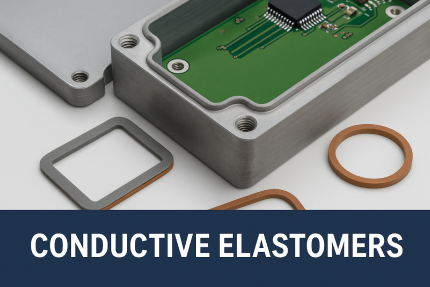When electrical engineers and system integrators discuss EMI shielding, the focus often falls on decibel values, part geometry, or environmental performance. But behind every high-reliability EMI gasket is a foundation of electromagnetic theory and current distribution mechanics that governs how well a shielding interface actually performs.
At Matrix Technology, we partner with Parker Chomerics not only to supply industry-leading conductive elastomer materials but to help our customers understand and apply the physics behind gasket design for EMI/EMC compliance. Whether you’re shielding a secure avionics bay or ruggedizing satellite communications, understanding how current flows through shielding seams is critical to achieving high shielding effectiveness and long-term system integrity.
What Does an EMI Gasket Really Do?
At its core, an EMI gasket serves to restore continuity across gaps in conductive enclosures. Every enclosure, from milled aluminum housings to composite radomes, has imperfect joints—flanged seams, screwed lids, removable covers. These interfaces introduce physical and electrical discontinuities that can allow electromagnetic radiation to leak in or out.
EMI Gasket = Electrical Bridge
An EMI gasket acts as a low-impedance pathway for surface currents, maintaining the shielding effectiveness of the enclosure. When placed under compression between two conductive flanges, the gasket completes the Faraday cage, preventing signal leakage and minimizing RF ingress.
The Theory of Current Flow Across Gasket Interfaces
Section 10 of the Parker Chomerics Handbook outlines the electromagnetic principles behind shielding interfaces. When current flows along a conductive surface, any gap or slot in that surface will cause the current to diverge—seeking the path of least resistance, or in worst-case scenarios, radiating into free space.
Two critical leakage modes must be understood:
1. Material Penetration Leakage
Occurs when current flows through a gasket material of lower conductivity than the surrounding shield. Since the elastomer’s conductivity is typically orders of magnitude lower than the metal housing, the surface current experiences attenuation, resulting in field leakage on the far side of the seam.
2. Interface Leakage
Happens when imperfect physical contact (due to poor compression, surface roughness, corrosion, or aging) creates air gaps or high-resistance junctions. Current is then diverted to discrete contact points, leading to concentrated leakage fields and localized EMI hot spots.
The solution? Gaskets that are both:
- Electrically conductive
- Mechanically conformable
This dual role ensures the continuity of current paths while adapting to surface imperfections and maintaining a constant force across temperature cycles and vibration.
Conductive Elastomers as Engineered Shielding Interfaces
Parker Chomerics’ conductive elastomers—available through Matrix Technology—are specifically designed to address both leakage modes.
Conductivity
Fillers like silver-aluminum, silver-copper, and nickel-graphite embedded in a silicone or fluorosilicone binder provide the required conductivity (volume resistivity typically ≤ 0.01 Ω·cm). The result is an electrically continuous interface capable of maintaining low-impedance contact across shield joints.
Conformability
Silicone-based binders exhibit excellent compression set resistance and mechanical compliance. They maintain contact pressure across thousands of thermal cycles and under severe vibration, ensuring consistent performance even in aerospace and defense-grade conditions.
Design Parameters from Shielding Theory
Shielding performance depends on several mechanical and electrical variables:
| Parameter | Typical Engineering Target |
|---|---|
| Contact Resistance | < 20 mΩ across interface |
| Shielding Effectiveness | 80–120 dB from 20 MHz to 10 GHz |
| Compression Deflection | 10–30% for optimal conductivity |
| Seam Geometry | Continuous flange with uniform pressure |
| Material Selection | Based on galvanic match + environmental exposure |
Mathematical expressions (e.g., those derived from Maxwell’s equations and transmission line theory) show that impedance mismatches at seams directly correlate to increased emissions. Every milliohm matters—especially in high-speed digital, RF, or power-dense systems used in modern aerospace platforms.
Form Factor Meets Functionality: Custom Gasket Integration
Matrix Technology takes these principles off the page and into production. We offer:
- Custom-dispensed CHO-FORM® gaskets for complex housings and miniaturized devices
- Precision-cut gasket frames for RF shielding in sealed enclosures
- Hybrid EMI + environmental seals that combine IP67/68 ingress protection with high EMI shielding
- Electrically conductive FIP beads dispensed directly on magnesium, aluminum, and plated substrates
Whether you’re designing an ECU for a missile guidance system or a shielded backplane for UAV avionics, we help you maintain continuity—electrical, mechanical, and strategic.
From Theory to Battlefield-Ready Systems
Understanding the theory of shielding seams isn’t just academic—it’s the difference between electromagnetic compatibility and mission failure. At Matrix Technology, we engineer EMI gaskets that close the loop—literally and figuratively—on your shielding strategy.
We integrate:
- Material science from Parker Chomerics
- Advanced conversion and dispensing
- Design-for-manufacturing support
- And decades of real-world performance data
Ready to move from theory to application? Contact Matrix Technology to speak with an EMI specialist and develop the right shielding interface for your platform.
